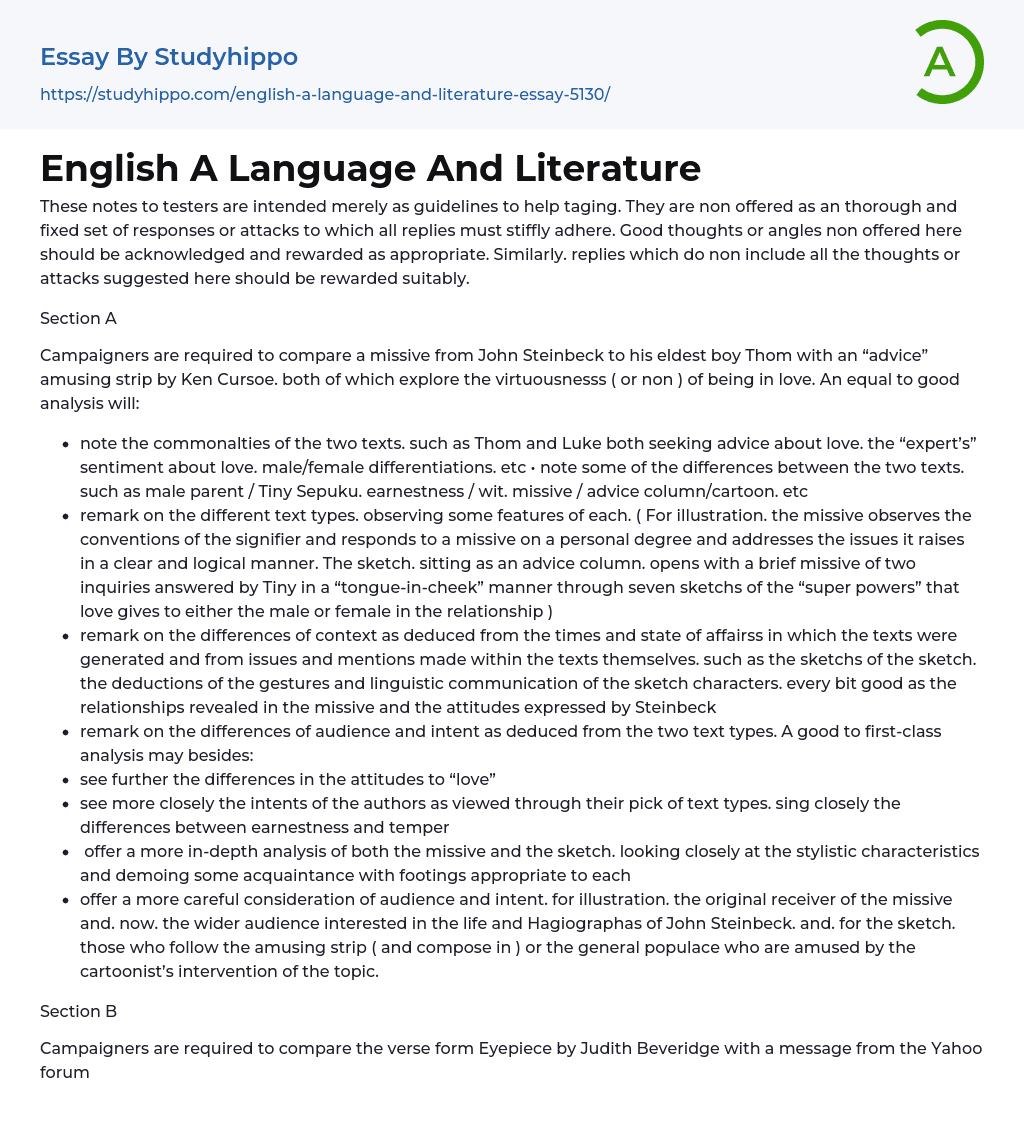These notes to testers are intended merely as guidelines to help taging. They are non offered as an thorough and fixed set of responses or attacks to which all replies must stiffly adhere. Good thoughts or angles non offered here should be acknowledged and rewarded as appropriate. Similarly. replies which do non include all the thoughts or attacks suggested here should be rewarded suitably.
Section A
Campaigners are required to compare a missive from John Steinbeck to his eldest boy Thom with an “advice” amusing strip by Ken Cursoe. both of which explore the virtuousnesss ( or non ) of being in love. An equal to good analysis will:
- note the commonalties of the two texts. such as Thom and Luke both seeking advice about love. the “expert’s” sentiment about love. male/female differentiations. etc • note some
...of the differences between the two texts. such as male parent / Tiny Sepuku. earnestness / wit. missive / advice column/cartoon. etc
- remark on the different text types. observing some features of each. ( For illustration. the missive observes the conventions of the signifier and responds to a missive on a personal degree and addresses the issues it raises in a clear and logical manner. The sketch. sitting as an advice column. opens with a brief missive of two inquiries answered by Tiny in a “tongue-in-cheek” manner through seven sketchs of the “super powers” that love gives to either the male or female in the relationship )
- remark on the differences of context as deduced from the times and state of affairss in which the texts were generated and from issues and mentions made within the texts themselves. such as
View entire sampleJoin StudyHippo to see entire essay
the sketchs of the sketch. the deductions of the gestures and linguistic communication of the sketch characters. every bit good as the relationships revealed in the missive and the attitudes expressed by Steinbeck
Section B
Campaigners are required to compare the verse form Eyepiece by Judith Beveridge with a message from the Yahoo forum Microscope – Microscopy as a avocation or profession. which present. severally. nonliteral and actual positions of the universe seen through a microscope. An equal to good analysis will:
- note the commonalties of the two texts: the screening of the universe through a microscope. the designation of what is being looked at in each instance
- remark on the two text types researching some features of each ( the blend of personal and scientific remarks in the message. every bit good as the
nature of observation. both general and specific. the usage of scientific linguistic communication. the planetary nature of the “group. ” etc as opposed to the more refined qualities of the verse form: stanzas. lines. enjambement. simile. extended metaphor. initial rhyme. etc )
- Second Language essays
- English Language essays
- Semiotics essays
- Dialect essays
- Sign Language essays
- Spanish Language essays
- French Language essays
- Language Education essays
- Second Language Acquisition essays
- Teaching English As A Foreign Language essays
- Verb essays
- Gesture essays
- Book Summary essays
- Metaphor essays
- Reader essays
- Rhyme essays
- Literary devices essays
- Villain essays
- Books essays
- Genre essays
- Literary Criticism essays
- Writer essays
- Protagonist essays
- Simile essays
- Poem essays
- Book Report essays
- Book Review essays
- Greek Mythology essays
- Plot essays
- Tragic Hero essays
- Coming of Age essays
- Play essays
- Rhetoric essays
- Rhetorical Question essays
- Translation essays
- Understanding essays
- Reason essays
- Character essays
- Letter essays
- American Literature essays
- Literature Review essays
- Utopia essays
- Poetry Analysis essays
- Dante's Inferno essays
- Between The World and Me essays
- Incidents in The Life of a Slave Girl essays
- Flowers for Algernon essays
- Myth essays
- Everyday Use essays
- Boo Radley essays




